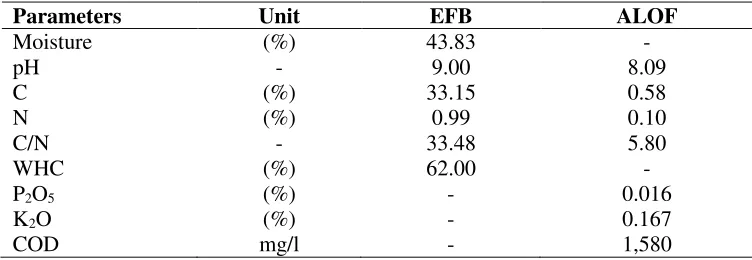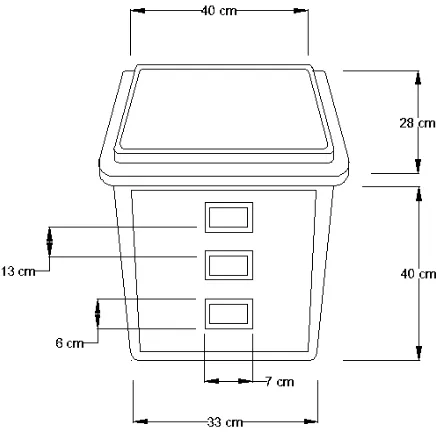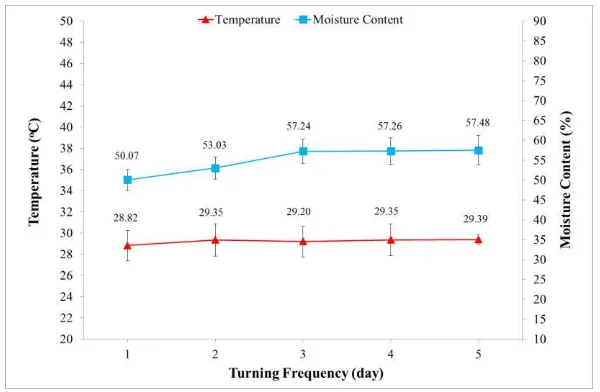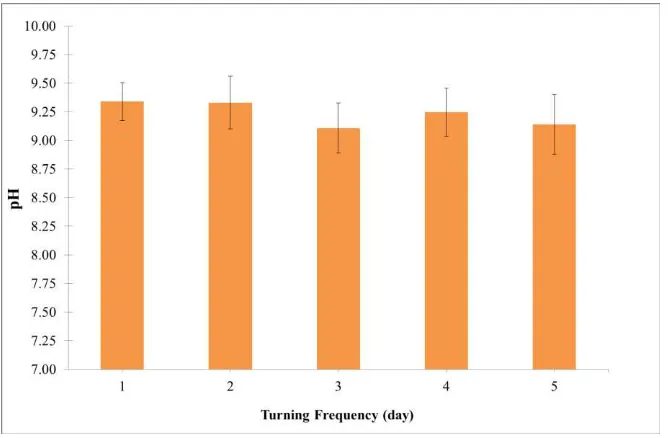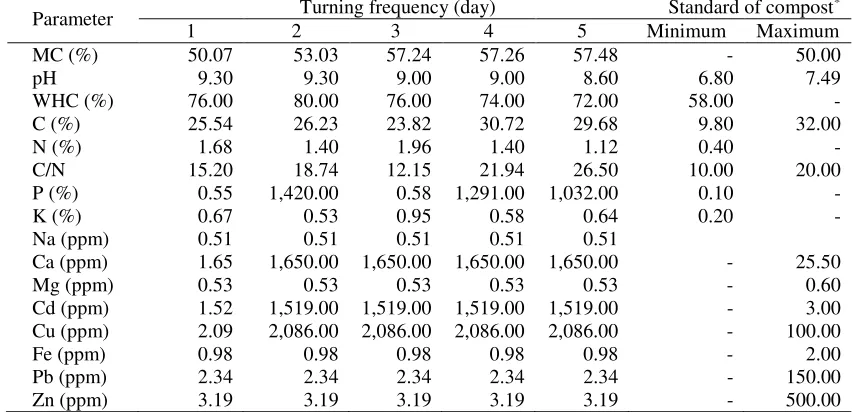IOP Conference Series: Materials Science and Engineering
PAPER • OPEN ACCESS
Effect of Turning Frequency on Composting of
Empty Fruit Bunches Mixed with Activated Liquid
Organic Fertilizer
To cite this article: B Trisakti et al 2017 IOP Conf. Ser.: Mater. Sci. Eng.180 012150
View the article online for updates and enhancements.
Related content
Effect of pieces size of Empty Fruit Bunches (EFB) on composting of EFB mixed with activated liquid organic fertilizer B Trisakti, P Mhardela, T Husaini et al.
-Composting of empty fruit bunches in the tower composter – effect of air intake holes
Irvan, T Husaini, B Trisakti et al.
-Electricity generation from palm oil tree empty fruit bunch (EFB) using dual chamber microbial fuel cell (MFC) N F Ghazali, N A B N Mahmood, K A Ibrahim et al.
Effect of Turning Frequency on Composting of Empty Fruit
Bunches Mixed with Activated Liquid Organic Fertilizer
B Trisakti*, J Lubis, T Husaini, and Irvan
Chemical Engineering Department, Faculty of Engineering, University of Sumatera Utara. Jalan Almamater Komplek USU Medan, 20155, Indonesia
Abstract. Composting of Empty Fruit Bunch (EFB) by mixing it with activated liquid organic fertilizer (ALOF) is an alternative way in the utilization of solid waste produced from the palm oil mill (POM). This research was to determine the effect of turning frequency on the rate of composting of EFB mixed with ALOF in a basket composter. The composting process was started with cutting the EFB into pieces with size 1-3 cm, inserting the EFB pieces into basket composter (33 cm W × 28 cm L × 40 cm H), and adding ALOF until moisture content (MC) in the range of 55-65%. During composting, the MC was maintained at 55-65% range by adding the ALOF. The turning frequency on each composter was varied i.e. once in every 1, 2, 3, 4, and 5 days. The parameters analysed during composting were temperature, pH, MC, compost weight, water holding capacity (WHC), CN ratio, and the quality of the final compost. Composting was carried out for 40 days and the best result obtained at turning frequency was 3 days. The best compost characteristic was pH 9.0; MC 57.24%; WHC 76%; CN ratio 12.15%; P 0.58%; and K 0. 95%.
1. Introduction
In the processing of fresh fruit bunches (FFB), besides producing palm oil and palm kernel, palm oil mills (POM) also produce liquid and solid wastes. For every ton of FFB processed will produce approximately 0.6 to 0.87 m3 liquid wastes or 2.4 to 3.7 tons of liquid wastes per one ton of palm oil
produced [1] with biological oxygen demand (BOD) of 20,000-25,000 mg/L, chemical oxygen demand (COD) of 40,000-50,000 mg/L and pH 3.8-4.5 [2]. Besides liquid wastes, POM also generates large amount of solids wastes such as empty fruit bunch (EFB) (23%), shell (5%), and mesocarp fiber (12%) for every ton of FFB processed in the mills [3].
Previously, the EFB is burned in an incinerator to ashes. The ash of EFB can be used as fertilizer, because relatively high content of potassium is ± 30%. However, Minister of the Environment Decree number 15 of 1996 on the blue-sky program. In preventing air, pollution bans the combustion process.
Today, most EFB is used as mulch on oil palm lands by placing EFB around the palm tree. Although the existence of mulch is useful to control weeds, maintain moisture and prevent soil erosion but its utilization is costly for labor and transportation [4]. Moreover, the processes of composting of mulch take a long time depending on environmental factors. Therefore, EFB should be composted before being spreaded to the field, or distributed to the farmers. Compost will also become potential products when used for the cultivation of ornamental plants.
Composting is a means to change various organic wastes into products that can be used safely and profitably as a biological fertilizer. The main function of the compost is to help improve the physical, chemical and biological of soil. Physically, compost can loosen the soil, compost application into the soil increase the number of cavities so that the soil becomes loose. While chemical properties capable addressed by the application of compost is increasing the action exchange capacity (CEC) of the soil and can increase the ability of soil to water retain (water holding capacity). As for the improvement of biological characteristics, the compost can improve soil microorganism populations [5]. The composting process are influenced by number of factors such as nutrients, C-N ratio, size of the compost material, temperature, pH, water content, and turning frequency [6].
Several studies have been conducted to process EFB into compost by mixing it with additional materials such as manure [7] or palm oil mill effluent (POME) [8]. This research used activated liquid organic fertilizer (ALOF) as alternative additional materials. ALOF is product of advance fermentation of treated biogas effluent from methanogenic anaerobic digester, which still has high nutritional and microbial sources. Hence, mixing EFB with ALOF in the basket composter might enrich the compost material with high nutrient and microbial sources. Therefore, the aim of this research is to determine the effect of turning frequency on the rate of composting of EFB mixed with ALOF in a basket composter.
2. Materials and Methods
2.1. Materials
Main materials in this research were EFB and ALOF. EFBs were obtained from Rambutan POM, Sumatera Utara, Indonesia. Before being used, the EFB was shredded and cut to size of 1 - 3 cm. While, ALOF were liquid product from methanogenic anaerobic digestion obtained from USU - Biogas Pilot Plant, Pusdiklat LPPM, USU, Medan, Indonesia. Characteristics of EFB and ALOF are presented in Table 1.
Table 1. Characteristic of EFB and ALOF
Parameters Unit EFB ALOF usually used as a laundry basket. Inside of the basket is covered with perforated carpet in order to control the influx of oxygen and to release the gases as composting product. The front side of composter is equipped with three holes, which are used for sampling and temperature measurements. Detailed sketch of the composter is presented in Figure 1.
2.3. Composting Process
Composting process was started by shredding and cutting EFB to size of 1-3 cm, measuring the weight of total EFB, and putting into the composter. Next, ALOF was poured and mixed until the moisture content of compost reached 55-65% and maintained at that value range during the composting proceed.
2
During the process, compost pile was turned every one, two, three, four, and five days in order to reduce and equalize the moisture content.
Figure 1. Basket Composter
2.4. Sampling and Data Collection
Sampling was carried out by collecting approximately 20 g of composting materials through sampling holes. Meanwhile, temperature measurement was performed by inserting digital thermometer through thermometer holes. Data collected during the experiment were temperature, moisture content (MC), pH, CN ratio, and compost quality. Temperature measurement was performed twice a day, in the morning and afternoon. Moisture content was determined everyday by drying oven method. pH was measured every two days. Content of C and N were determined on days 0th, 10th, and 40th, by Walkley & Black and Kjeldahl methods.
3. Results and Discussions
The composting process of EFB from palm oil mill was carried out by shredding and cutting EFB to size of 1-3 cm and mixing with ALOF. Composting process was conducted in the basket composter with turning frequency every one, two, three, four, and five days. Composting process was evaluated for 40
days by measuring and determining the temperature, moisture content (MC), pH, CN ratio, and others
compost quality. The results of the research are described in this following section.
3.1. Effect of Turning Frequency on Temperature and Moisture Content
Temperature and moisture content are the most important parameter to be measured in the composting process [9]. The average of temperature and moisture content during the composting process that turning every one, two, three, four and five days is presented in Figure 2.
Figure 2 shows that the average temperature in compost turning every one, two, three, four, and five days were 28.82 ± 1.43, 29.35 ± 1.53, 29.20 ± 1.46, 29.35 ± 1.50, and 29.40 ± 0.43°C, respectively. This means, the increasing of turning frequency of compost material caused the decreasing of composting temperature. This is consistent with the research reported by Shen et al. [10] and Saidi et al. [11]. Temperature of the compost pile will be lower due to the cooling effect caused by the magnitude of the turning frequency. The error bar at temperature curve shows the temperature difference at each part of
compost material pile, because the activity of microorganisms in each section height of compost material pile is different [12].
Figure 2. Effect of turning frequency on temperature and moisture content
Figure 2 also shows that the average MC in compost turning every one, two, three, four, and five days were 50.07 ± 2.62, 53.03 ± 2.76, 57.24 ± 3:05, 57.26 ± 3.32, and 57.48 ± 3.68%, respectively. Although the value of average MC increased with the decreasing of turning frequency but the values are in the range of 50.07 - 57.48% or still in the range of best MC value for composting [3, 13]. Baharuddin et al. [3] reported that the best of MC value for composting is in the range of 55-65%. If the MC value is too high, it can inhibit the growth of microorganisms because water molecules are going to fill the air cavity resulting in anaerobic conditions, which will cause odor and can kill aerobic microorganisms due to oxygen deficiency [10, 12].
3.2. Effect of Turning Frequency on ALOF Addition
ALOF addition in each composter depends on the MC value of compost pile. It is maintained in the range of 55-65%. Therefore, at the end of composting, the total number of ALOF added to each composter is different. The ALOF amount, which is added to the composter that turned every one, two, three, four, and five days, is presented in Figure 3.
Figure 3. Effect of turning frequency on ALOF addition
4
Figure 3 shows that the total addition of ALOF in compost turning every one, two, three, four, and five days were 11:05, 10.68, 11.91, 11.61 and 10:23 liters, respectively. The biggest ALOF addition is at compost, which is turned in every three days and the smallest in compost turning every five days. Nevertheless, the difference is relatively small due to the average of ALOF addition was 11:07 ± 1:19.
3.3. Effect of Turning Frequency on pH
The average value of compost pH during the composting process that turning every one, two, three, four and five days is presented in Figure 4.
Figure 4. Effect of turning frequency on compost pH
Figure 4 shows that the average value of compost pH in compost turning every one, two, three, four, and five days were 9.34 ± 0.17, 9.33 ± 0.23, 9.11 ± 0.22, 9.25 ± 0.21, and 9.14 ± 0.26%, respectively.
The highest average value of compost pH is at turning of the compost pile every day and tends to fall with decreasing of turning frequency, but the lowest pH value is at turning every three days. It means if the compost pile is more often turned then the pH of the compost tends to be greater.
The pH value of the compost tend to base condition and this is good because it can inhibit the growth of pathogens such as fungi that can survive in acidic conditions [11]. The base condition happens because of the turning process is performed on the compost pile during the proses. By performing the turning process, it can emit CO2 gas, which is trapped in the empty space among particles of the
composting material, thus preventing the acidic conditions in the compost pile or significant decrease in pH [14, 15].
3.4. Effect of Turning Frequency on C-N Ratio
Maturity and quality of the compost produced is determined by analyzing the compost based on the C-N ratio. The C-C-N ratio of the compost material at 0th, 40th, and 60th day in compost turning every one,
two, three, four, and five days is presented in Figure 5.
Figure 5 shows that the initial C-N ratio of composting material at each turning frequency variation is the same, i.e. 33.48. On the 40th day, the C-N ratio of the compost drastically decreased, where the value for turn of a compost pile every one, two, three, four, and five days were 15.2, 18.74, 12.15, 21.94 and 26.5, respectively. Finally, on the 60th day, the C-N ratio for the compost pile turned every one, two, three, four, and five days was 11.9, 11.74, 11.74, 14.69, and 10:47, respectively. The C-N ratio decreases is occurs because of the organic matter decomposition as the results of microbial activity [16, 17].
Figure 5. Effect of turning frequency on C-N ratio
On 60th day, C-N ratio for each turning variation is below 20, it means the compost is already mature
and appropriate with the quality of the standard of C-N ratio of compost mature i.e. in the range of 10-20 [8, 18]. While on the 40th day, only in compost turning every one, two, and three days the value of
the C-N ratio in the range of 10-20, while in in compost turning every four and five days the C-N ratio is still above 20. The best C-N ratio on the 40th day is on compost pile turning every three days i.e. 12:15.
The C-N ratio is better than the more frequent turning that every one and two days as well as the rarer turning that four and five days. Turning frequency of the compost pile too rare will cause no uniform distribution of temperature, nutrients, water, and oxygen causing microbial activity is low [18]. When, turning frequency of the compost pile that is too often will potentially eliminate the heat on the compost pile produced by microbial activity, so that it can interfere with the process of decomposition that took place [12]. Results of complete analysis of compost quality and standard of compost are presented in Table 2.
Table 2. Results of complete analysis of compost quality and standard of compost
Parameter Turning frequency (day) Standard of compost
*
1 2 3 4 5 Minimum Maximum
MC (%) 50.07 53.03 57.24 57.26 57.48 - 50.00 pH 9.30 9.30 9.00 9.00 8.60 6.80 7.49 WHC (%) 76.00 80.00 76.00 74.00 72.00 58.00 - C (%) 25.54 26.23 23.82 30.72 29.68 9.80 32.00 N (%) 1.68 1.40 1.96 1.40 1.12 0.40 - C/N 15.20 18.74 12.15 21.94 26.50 10.00 20.00 P (%) 0.55 1,420.00 0.58 1,291.00 1,032.00 0.10 - K (%) 0.67 0.53 0.95 0.58 0.64 0.20 - Na (ppm) 0.51 0.51 0.51 0.51 0.51
Ca (ppm) 1.65 1,650.00 1,650.00 1,650.00 1,650.00 - 25.50 Mg (ppm) 0.53 0.53 0.53 0.53 0.53 - 0.60 Cd (ppm) 1.52 1,519.00 1,519.00 1,519.00 1,519.00 - 3.00 Cu (ppm) 2.09 2,086.00 2,086.00 2,086.00 2,086.00 - 100.00 Fe (ppm) 0.98 0.98 0.98 0.98 0.98 - 2.00 Pb (ppm) 2.34 2.34 2.34 2.34 2.34 - 150.00 Zn (ppm) 3.19 3.19 3.19 3.19 3.19 - 500.00
*Standards of compost according to the Indonesian National Standard
6
4. Conclusions
Composting of empty fruit bunches (EFB) mixed with activated liquid organic fertilizer (ALOF) was carried out for 40 days and the best result obtained at turning frequency was three days. The best compost characteristic was pH 9.0, MC 57.24%, WHC 76%, CN ratio 12.15%, P 0.58%, and K 0. 95%.
Acknowledgments
This research was financially supported by Penelitian Bidang Keunggulan Akademik (TALENTA) Universitas Sumatera Utara (USU) fiscal year 2016 No. 31/UN5.2.3.1/PPM/2016.
References
[1] Trisakti B, Manalu V, Taslim I and Turmuzi M 2015 Acidogenesis of palm oil mill effluent to
produce biogas: effect of hydraulic retention time and pH Procedia-Social and Behavioral Sciences195 2466-2474
[2] Trisakti B, Sosanty F and Tomiuchi Y 2016 Effect of discontinuing sodium bicarbonate on fermentation process of palm oil mill effluent Asian Journal of Chemistry28(2) 377
[3] Baharuddin A S, Hock L S, Yusof M Z, Rahman N A A, Shah U K, Hassan M A and Shirai Y
2010 Effects of palm oil mill effluent (POME) anaerobic sludge from 500 m3 of closed
anaerobic methane digested tank on pressed-shredded empty fruit bunch (EFB) composting process African Journal of Biotechnology9 (16) 2427-2436
[4] Kavitha B, Jothimani P and Rajannan G 2013 Empty fruit bunch-a potential organic manure for
agriculture Int J Sci Environ Technol2 930-937
[5] Oviasogie P O, Aisueni N O and Brown G E 2010 Oil palm composted biomass: A review of the
preparation, utilization, handling and storage African Journal of Agricultural Research5 (13) 1553-1571
[6] Tchobanoglous G, Theisen H and Vigil S 1993 Integrated solid waste management: engineering
principles and management issues McGraw-Hill Science/Engineering/Math
[7] Suhaimi M and Ong H K 2001 Composting Empty Fruit Bunches of Oil Palm. Extension Bulletin
- Food & Fertilizer Technology Center 505 1-8
[8] Baharuddin A S, Wakisaka M, Shirai Y, Abd-Aziz S, Abdul R N A and Hassan M A 2009
Co-composting of empty fruit bunches and partially treated palm oil mill effluents in pilot scale International Journal of Agricultural Research4 (2) 69-78
[9] Saiidi S, Hasani M, Hashemi J and Amini-rad M 2012 Investigation of optimum conditions of
co-composting process by using of sewage sludge and municipally waste The 1th International and the 4th National Congress on Recycling of Organic Waste in Agricultural, Isfahan, Iran.
[10] Shen Y, Ren L, Li G, Chen T and Guo R 2011 Influence of aeration on CH 4, N 2 O and NH 3
emissions during aerobic composting of a chicken manure and high C/N waste mixture Waste
Management31 (1) 33-38
[11] Saidi N, Chérif M, Jedidi N, Mahrouk M, Fumio M, Boudabous A and Hassen A 2008 Evolution
of Biochemical Parameters during Composting of Various Wastes Compost American Journal
of Environmental Science4 (4) 332 - 341
[12] Tiquia S M, Tam N F Y and Hodgkiss I J 1997 Effects of turning frequency on composting of
spent pig-manure sawdust litter Bioresource Technology62(1-2) 37-42
[13] Razali W A W, Baharuddin A S, Talib A T, Sulaiman A, Naim M N, Hassan M A and Shirai Y
2012 Degradation of oil palm empty fruit bunches (OPEFB) fibre during composting process
using in-vessel composter BioResources7(4) 4786-4805
[14] Liu H T and Cai L 2014 Effect of sewage sludge addition on the completion of aerobic composting
of thermally hydrolyzed kitchen biogas residue BioResources9(3) 4862-4872
[15] Sekman E, Top S, Varank G and Bilgili M S 2011 Pilot-scale investigation of aeration rate effect
on leachate characteristics in landfills Fresenius Environmental Bulletin20 (7)
[16] Razali W A W, Baharuddin A S, Talib A T, Sulaiman A, Naim M N, Hassan M A and Shirai Y 2012 Degradation of oil palm empty fruit bunches (OPEFB) fiber during composting process
using in-vessel composter Bio Resources7(4) 4786-4805
[17] Lim S H, Samsu B A, Ahmad M N, Shah M, Kalsom U, Rahman A and Shirai Y 2009
Physicochemical changes in windrow co-composting process of oil palm mesocarp fiber and palm oil mill effluent anaerobic sludge Australian Journal of Basic and Applied Sciences3 (3) 2809-2816
[18] Zahrim A Y and Asis T 2010 Production of Non-Shredded Empty Fruit Bunch Semi Compost
Journal-The Institution of Engineers, Malaysia71 (4) 11 - 17
8
